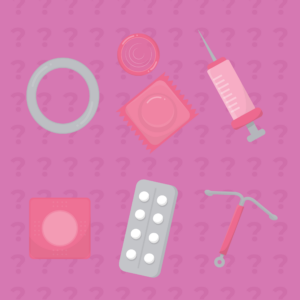What Birth Control is Right for You?


- Implant– a type of birth control, shaped like a small rod, that is placed into your upper arm by a healthcare professional
- More than 99% effective
- Low maintenance
- Lasts up to three years
- Side effects-irregular bleeding and spotting, possible weight gain, acne, mood changes, or pain/scarring at the insertion site.
- Hormonal IUD– a small T shaped device placed into the uterus by a healthcare professional
- More than 99% effective
- Lasts between 3-6 years
- Low maintenance
- Side effects-irregular bleeding and spotting between periods, cramping and discomfort when placed
- Non-Hormonal IUD– a small T shaped device wrapped in copper and inserted into the uterus by a healthcare professional, does not use hormones
- More than 99% effective
- Lasts up to 10 years
- Can be used as emergency contraception
- Low maintenance
- Side effects-irregular bleeding and spotting between periods; cramping and some discomfort when placed; can occasionally cause heavier, longer periods
- Birth Control Shot– a shot given in the upper arm by a healthcare professional every three months (sometimes referred to as the depo shot)
- 94% effective with typical use
- Each shot lasts three weeks
- Requires you to see your provider every three months
- Side effects-potential weight gain and mood changes; irregular bleeding
- Birth Control Pills -A prescription from your healthcare provider; variety of brands and pills
- 91% effective with typical use
- Available by prescription only
- Requires you to take a pill each day, at the same time every day
- Side effects-breast tenderness, nausea, irregular bleeding, and headaches but often improves over time; can interact with certain antibiotics, anti-seizure, and HIV medications
- Ring– a small flexible ring you put into your vagina for three weeks, removing for one week, and then starting the process over again with a new ring
- 91% effective with typical use
- Available by prescription only
- Requires you to remember to insert it on time and remove it on time
- Side effects-breast tenderness, nausea, unusual bleeding, headaches and mood changes that should improve over time; may interact with certain antibiotics, anti-seizure, and HIV medications
- Patch– a thin, bendable piece of plastic that looks like a square bandage (sticky on one side) that you replace every week for three weeks, leave off for one week, and then start the process over again
- 91% effective with typical use
- Available by prescription use only
- Requires you to remember to place it on time each week
- Side effects-breast tenderness, nausea, unusual bleeding, headaches and mood changes that should improve over time; may interact with certain antibiotics, anti-seizure, and HIV medications
https://www.nationwidechildrens.org/specialties/bc4teens/resources/which-birth-control-is-right-for-me
Understanding Preeclampsia


Some women are at a higher risk of developing preeclampsia. If you have a history of high blood pressure, kidney disease, or diabetes; are expecting multiples, have a family history of preeclampsia; have an autoimmune condition like lupus, and/or are obese, you may be at an increased risk of developing this condition.
Symptoms for preeclampsia include:
- Headaches
- Blurry vision or light sensitivity
- Dark spots appearing in your vision
- Right side abdominal pain
- Swelling in your hands and face
- Shortness of breath
Symptoms of severe preeclampsia include:
- Blood pressure of 160/110 or higher
- Decreased kidney or liver function
- Fluid in the lungs
- Low blood platelet levels
- Decreased urine production
At your prenatal appointment, someone should check your blood pressure levels. However, if you experience sudden swelling, headaches, blurry vision, or any of the other symptoms listed above in between appointments, it’s important to call your doctor’s office and let them know.
https://my.clevelandclinic.org/health/diseases/17952-preeclampsia
Parmesan Zucchini Fritters


- 1 lb zucchini (about two large ones)
- ½ onion, finely chopped
- 3 large eggs, beaten
- ½ tsp. garlic powder
- Salt and pepper
- ½ cup freshly grated parmesan cheese
- ¾ cup all-purpose flour
- 1 ½ tbsp. olive oil
- ½ cup marinara sauce
- 1 tbsp. thinly sliced fresh basil
- 1 clove garlic, minced
- 1 tsp. crushed red pepper flakes
Directions:
Step One: On the large holes of a box grater, grate zucchini. Using a cheesecloth or clean dish towel, squeeze out as much liquid as possible.
Step Two: In a large bowl, combine shredded zucchini with onion, eggs, and garlic powder. Season with salt and pepper and stir to combine. Mix in parmesan and flour and stir until fully incorporated.
Step Three: In a large skillet over medium-high heat, heat olive oil. For each fritter, scoop ¼ cup batter into skillet and cook until golden, 2 minutes per side.
Step Four: In a small bowl, combine marinara with basil, garlic and red pepper flakes. Serve fritters with sauce.
https://www.delish.com/cooking/recipe-ideas/recipes/a54809/parmesan-zucchini-fritters-recipe/Yeah right






